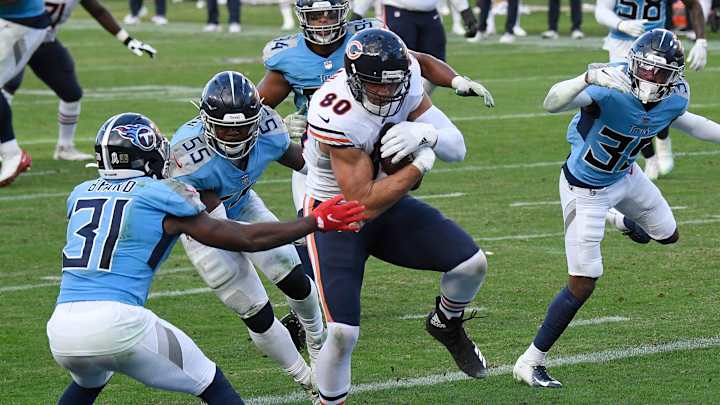Red Zone Trouble Doesn't Add Up for Bears

During red zone drills at minicamp, Justin Fields showed one way he might help turn around Bears offensive fortunes.
After he threw an interception on one play, he bought time with his feet on another play as rushers started closing in and, on the run, put a laser strike in the hands of tight end Cole Kmet.
Fields' speed is a huge weapon as a runner but the Bears can use it in the red zone by letting him buy time with quickness like he did on the pass to Kmet.
Two of the top three red zone teams in the league last year were Green Bay and Seattle and both Aaron Rodgers and Russell Wilson are masters at buying time with their feet to extend plays before the receiver comes free.
It doesn't mean everything, though.
The Ravens have the best running quarterback in football and ranked only 15th in red zone scoring and even with quick-footed Patrick Mahomes Kansas City was 16th. Houston has Deshaun Watson and was 25th.
The Bears red zone offense needs upgrading whether it's Fields playing or Andy Dalton, whether they have individuals making plays or not. They just haven't been good at it.
"We're going to really emphasize the red zone in training camp," coach Matt Nagy said. "I think it's going to be important to look at that and continue to hit conceptually what we have and then what our players do well.
"When you get down in there, you can't kick field goals. You got to have touchdowns. You have to score points."
The Bears were 11th in red zone scoring during Nagy's first year in Chicago, when they ran the ball better overall using Jordan Howard behind a line still in tune with his running style. They've been ranked 24th and 22nd the last two years in red zone TD percentage despite having acrobatic, sure-handed receiver Allen Robinson, a mobile passer in Mitchell Trubisky and last year Jimmy Graham as a dependable red zone target.
Graham finished tied for seventh in Red Zone TD catches with seven and had 13 total red zone receptions in 19 targets.
However, Robinson caught four red zone TDs and six TDs overall. He had the lowest red zone reception percentage in relationship to total targets from among all NFL players who caught at least seven red zone passes, at 38.89%. He had 18 targets with his seven receptions.
Some of that inefficiency can be blamed on the quarterback. Trubisky tied for the league lead in 2019 in red zone interceptions, and last year played only half a season but still threw two red zone picks. In the year when he led the league, Trubisky threw four red zone interceptions.
They signed Dalton and last year he played in 11 games for Dallas with nine starts but still shared the league lead in red zone interceptions thrown with three.
Robinson says he's doing his part physically to be a better red zone target for whoever is throwing the passes this time.
"Being able to make sure I'm not only honing in on the physical standpoint, but just honing in on what opponents are trying to do to us in the red zone, and how I can be better, and how I can assist my team more in the red zone when we do get down there," he said.
The running game was only slightly better in the red zone than the passing game. David Montgomery tied for 15th in rushing touchdowns inside the opposing 20 for a second straight year, although it was with seven last season. He had six when he did this in 2019.
#OhioState QB Justin Fields — Red zone situation.
— Matt Bowen (@MattBowen41) April 7, 2021
Escape/extend — with the eyes up. ID the open void, throw with touch/location. @NFLMatchup pic.twitter.com/cCNHMXkY1Z
Bringing in two big tackles in the draft made sense from this standpoint.
Considering their individual statistics in the red zone weren't the worst but the sum total of all efforts ranked the offense so poorly, Nagy and coaches are attempting to overhaul play design and possibly calls.
"There's some concepts that we'll keep. There's some concepts that we'll add," Nagy said.
He said they'd study film of other teams who succeed in the red zone and those who don't.
"Is it just guys making good plays or is it schematics?" Nagy said. "That's kind of where we're at.
"We're excited in training camp to really put an emphasis on it."
Twitter: BearDigest@BearsOnMaven
